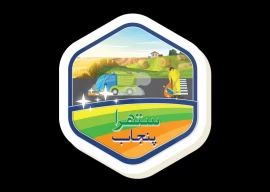
Forests in Balochistan, Murree and Gilgit-Baltistan (G-B) might benefit from an international mechanism that would financially reward countries for using forests to reduce global warming.
A national consultative meeting to discuss the mechanism --- the United Nations Reduced Emissions from Deforestation and Forest Degradation Plus (REDD+) --- was held in Islamabad this week.
Secretaries from all the provinces, federal government officials and representatives of nongovernment environmental organisations such as the World Wildlife Fund (WWF) and International Union for the Conservation of Nature attended the meeting.
Participants prioritised the Ziarat and Harboi Juniper forests, Chilgoza forests of Balochistan, Guzara forests in Murree and Kahuta and the community-owned forests of Darel-Tangir in G-B as potential sites for REDD+ pilot projects.

Qazi Azmat Isa, the meeting’s chief guest and chief executive officer of the Pakistan Poverty Alleviation Fund (PPAF), said he would dedicate PPAF staff to start with a pilot project in at least three of the sites immediately.
Balochistan Forests Secretary Rahim Khudai Ejbani and Isa discussed immediate steps to save the Ziarat Juniper forest, a World Heritage Site.
Trees can store the greenhouse gas carbon dioxide, emissions of which contribute to global warming. By increasing forest areas, countries can reduce carbon emissions. The REDD+ mechanism provides countries a financial incentive to save forests, increase forest area and “invest in low-carbon paths to sustainable development,” according to the REDD+ official webpage.
It is estimated that Pakistan can earn $400 million to $4 billion each year for carbon stored in the country’s forests, figures that could potentially overshadow what the country earns from textile exports. Soil erosion control, wildlife conservation and poverty alleviation through alternative livelihood opportunities for forest communities are additional benefits of implementing a REDD+ strategy.
But in order to reap those benefits, Pakistan needs to build capacity for REDD+ through policymaking and also quantify the amount of carbon stored in its forests scientifically.

At the moment, even the total forest area in Pakistan is a disputed figure with official estimates putting it at 5.2 per cent of total land area and international reports claiming the forest cover is as low as 2.1 per cent.
Mahmood Nasir, the inspector general of forests at the Climate Change Division, said Pakistan’s REDD+ proposal should be defended in the World Bank and the Forest Carbon Partnership Facility meeting to be held in Geneva in December.
Nasir said only three countries are expected to get around $4 million to implement the projects out of 12 competing developing countries.
Climate Change Secretary Raja Hassan Abbas said the federal government will coordinate and facilitate the provinces to honour the international treaties Pakistan has ratified.
The Food and Agricultural Organisation (FAO) has committed to help Pakistan under REDD+, David Doolan, the FAO representative in Pakistan, said.
Nomadic forest users were represented at the meeting by Pakistan Gujjar Bakarwals, Guzara Forest Advisory Committee of Murree and Kahuta. Some forest owners from Hazara, G-B and Ziarat also attended the meeting.
Air Commodore (retd) Raja Hafeez, a member of the Guzara Advisory Committee of Murree and Kahuta, said private forest owners of his region should get acquainted with details of REDD+ so that the barren patches around Murree are brought back to their past glory. Hanif Parwana, chairman of the Gujjar Bakarwal Association of Pakistan, spoke on behalf of the nomadic grazers. Parwana claimed the grazers never cut trees as they know the goat herds will never survive without trees.
Dr Ghulam Akbar of WWF Pakistan said his organisation can bring in experts from WWF Nepal to Pakistan to conduct trainings for forest carbon measurements and monitoring.
Ejbani, Gilgit-Baltistan Secretary Forests Khadim Hussain and Khyber-Pakhtunkhwa Additional Secretary Environment Shaukat Yusufzai said the provincial REDD+ focal points have already been notified while work is in progress to establish REDD+ cells in the provinces.
Published in The Express Tribune, November 15th, 2013.
COMMENTS (20)
Comments are moderated and generally will be posted if they are on-topic and not abusive.
For more information, please see our Comments FAQ


1729080111-0/BeFunky-collage-(63)1729080111-0-165x106.webp)
1730838202-0/Trump-(1)1730838202-0-165x106.webp)













game of words nothing else.. on top of that the IGF is putting someone else's feather in his cap. Had the climate change division had potential they would have done this before. they are still fighting for what is left for whom
This a great news from Pakistan, a country with low forest cover and low on the global list of priority countries for international investment in REDD+. Getting in the list of 12 candidate countries is in itself a major achievement of Pakistan and for it I will give full credit to the relentless efforts and personal interest of Syed Mahmood Nasir IGF and his team. I wish him good luck with the final outcome and hope Pakistan is one the three finalist countries. Investment in REDD+ will not only bring sweet rewards to owners of Guzzara Forests who have made huge sacrifices to conserve their forests while they were disappearing fast elsewhere but also serve as a positive incentive to other forest owners. Just in case Pakistan is not one the three finalist countries should not mean "business as usual". Every year, all the provinces get a reasonable share of the PSDP for forestry sector and if we honestly believe in REDD+ policies and practices rather than the World Bank funds, then REDD+ should not get buried in files.
GOOD LUCK PAKISTAN!
We have good academic institutions and knowledge base to make REDD wok. Pakistan Forest Institute, Peshawar is known world over; while University of Agriculture, Faisalabad which is one of the top ranked universities of Pakistan and among top 100 universities of the world (in agriculture) has a full-fledged department offering B.Sc. (Hons.), M.Sc.(Hons.) and PhD degrees and similarly Institute of Agri. Extension & Rural Development has conducted in-depth research studies on socio-economic aspects of forest management. With a little investment in education/training and enhanced coordination between education, research and policy, Pakistan can become one of the leading countries regarding REDD.
Hope people who are concerned are following Warsaw Climate Talks I DOUBT THAT IN NEAR FUTURE ANY FINANCIAL INCENTIVE IS GOING TO FLOW FOR REDD PLUS. SO FAR NO INTERNATIONAL AGREEMENT HAS BEEN REACHED AND NO COMMITMENTS HAVE BEEN MADE. By IRSHAD KHAN
Pakistan has lesser problems and more potentials than many other REDD countries. Good Luck to whoever is steering this process it is a team work and getting the team on one pace is the real art
For REDD to be effective it a whole revamping of the system that is needed, this includes judiciary and politicians
This is really a good news for Pakistan,s forestry. I do hope that forest communities would be greatly benefited from this initiatives. Concerned authorities should aggressively take this issue. There are many other regions of KPK where REDD can be effectively implemented, but land tenure has to be clarified in some areas.
Before Pakistan gets a $ a transparent system has to be in place. The Forestry Institute Peshawar could play the role of independent monitoring of forests. But the problem is that bureaucracy by appointing non professional DGs added with tons of corruption makes it unacceptable. WHY FIA A FEDERAL Agecny was deputed when the Institute is a provincial one? As a proof please see the recent corruption where a account clerk was temporarily placed behind the bars and the DG was set free to loot.
please visit : http://pakobserver.net/detailnews.asp?id=183949
Saturday, November 24, 2012 - Peshawar—Federal Investigation Agency (FIA) has arrested an employee of Pakistan Forest Institute (PIF), Peshawar, on account of alleged corruption worth Rs 91 million. According to media reports, Muhammad Amjad s/o Muhammad Zaman who is among the PIF staff withdrew millions of rupees from State Bank in the form of bogus cheques in the name of construction of a public park in District Attock. The development project completed in 2009 whereas the accused kept chequebooks with him and withdrew the amount illegally.
Please see this advertisement:
If you are in Warsaw We invite you to discuss Private Sector investment at the International Launch of Dutch Private Sector REDD+ Initiative at COP19 in Warsaw
We are pleased to invite you to the launch of a unique Dutch private sector REDD+ initiative at the EU Pavilion, 2nd floor of the National Stadium in Warsaw on Saturday 16 November 18 PM. Hope Pakistan will catch with this chance For details please visit platformbee.nl, www.iucn.nl
Appears that the cat of REDD is out of the bag and now there is only one way that is save forests or vanish
REDD is hot item in the agenda of the current Climate Summit in Warsaw Poland called COP 19. I am sure Pakistan is working at Warsaw to raise its voice to get funding to save forests in developing countries
The population problem is same in whole of South Asia, REDD provides a forum to address the looming issues. Imagine when population will be again doubled in 30 years form now and more land will be needed to grow food. This land will come by clearing forests. No politics no corruption and no honesty can stop that conversion of forest land. All we need is to revive the systems of the British era who had done excellent planning for all generations. We have forgotten that the term "sustainable" forestry was designed and crafted by the great likes of Schilich and Brandis of the 19th century, we have just forgotten their systems. REDD provides a chance to revive the systems
If REDD can bring a transparent system the forests will be back on their own. The margin of profits for timber smuggling is simply so high that anyone could be purchased. In India there is a balance of power that is defined in federal and provincial forest Acts, Forest Code, Forest Manuals for example. But in Pakistan it is always adhoc basis depending on how corrupt is the Minister. Take for example the recent example of Khyber province where the Secretary forests under 4 Ministers approved a plan to harvest the remaining natural forests without taking into account the Forest Code and Working Plan Code. In both these legal documents there is no role of any Minister or Secretary ..... you can imagine what happened in background.....
The Indian model of balancing power between central and provincial governments is an example to follow that is why today in India forest area has increased to 24 percent from 19 in last 30 years. If PTI government is serious on forests then let them install a system. REMEMBER THE BRITISHERS ESTABLISHED THE SYSTEM OF FORESTS WITH LOTS OF WELL DEFINED POWERS TO LOCAL COMMUNITIES
One can gauge the complexity of this subject by the simple fact that the same news published by another English newspaper the same day gives the same figures of 4 billion $ in a different way that completely changes the meaning of climate change potential. Lesson learnt is that lots of investment is needed to build capacity of the media persons in particular who can work as agents of change. No Ministry can do it alone
I FIND THIS FROM THE SENIOR MOST FORESTER OF THE FOREST RICH PROVINCE AND AM CONFUSED: An excellent job done by Imran Khan PTI Chief without caring for his own Government in the KP Province. It was really fearless and lionhearted act by the Chief Minister KP to send the most corrupt Ministers of QWP packing home. The record of Forests Department speaks of the corrupt malpractices adopted by the Ibrar Hussain Minister Environment form the day 1 after taking oath. Even before he became Minister he was involved in smuggling of timber in organized manner. The private and self proclaimed PSO of the Minister namely Mr Ibrar Saeed acted as broker for the sacked Minister.he Minsiter was purterbed / distressed after Joint crack down of Forest department, District Administration and Police during Ist week of September 2013. The Minister recruited men of his own constituency in utter disregard to the approved policy. His brother ashiq Hussain alias Kala indulged in purchase of wood lots from the locals thereby depriving poor masses of monetary benefit
This is again a great service by Tribune we can but offer Tributes. What is needed is a political will. The recent removal of Minister Forests in one province may be a good signal that the government is serious about forests. Politics aside we need poltical will
Good news coming from Pakistan. This makes us proud that at last there is some attention to save our forests our common future
If Pakistan Poverty Fund has joined then I assume this story is all correct. Finance Ministry and the Prime Minister should have spearheaded this process and not left to ineffective Climate Division who are busy elsewhere